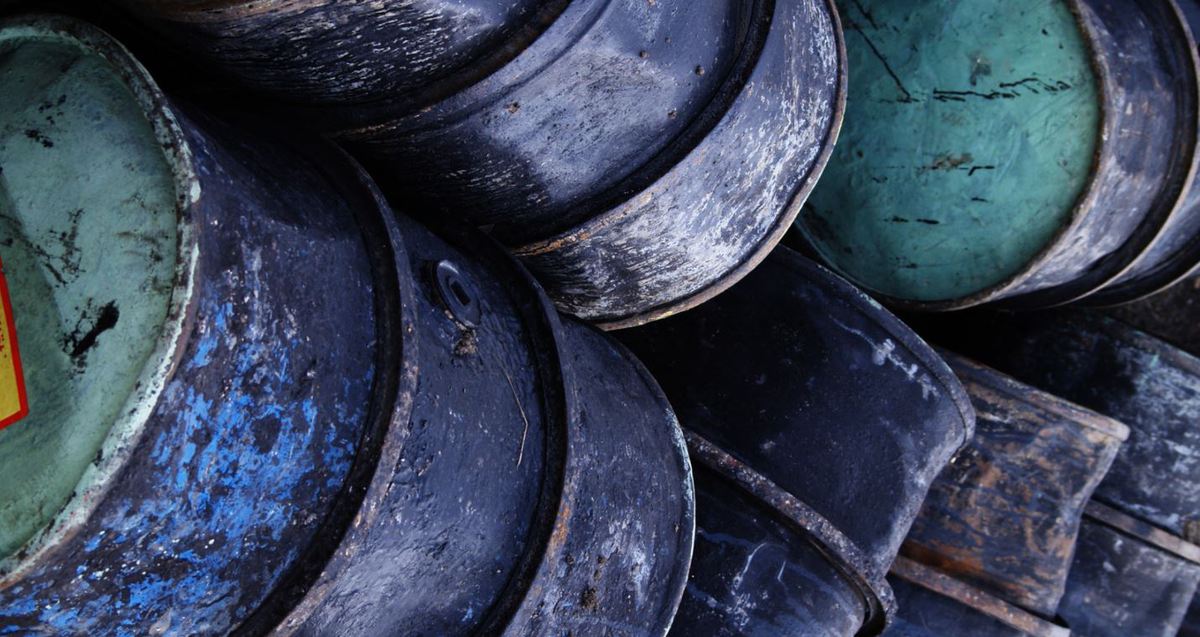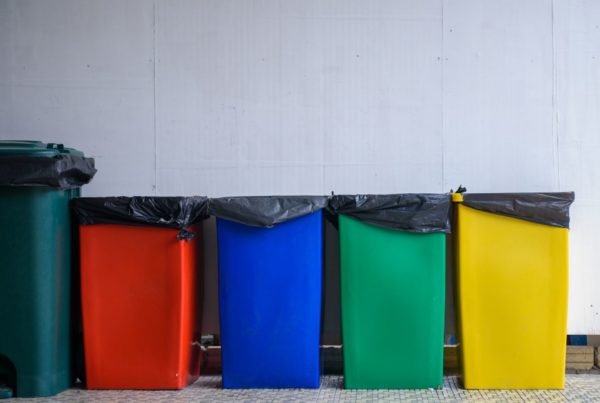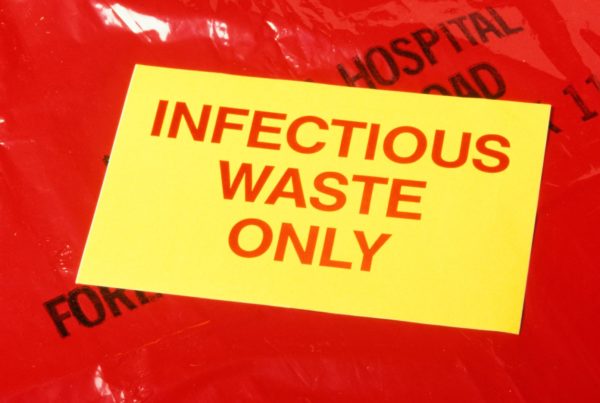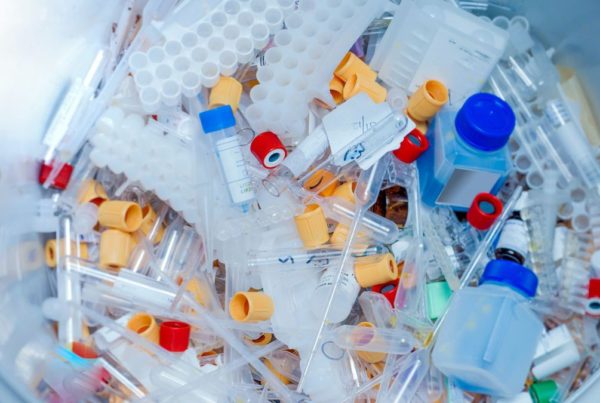Knowing how to properly dispose of chemical waste is essential for anyone who uses or creates chemicals in the course of their work. If disposed of improperly, hazardous chemical waste can contaminate the air, soil, and water and pose a threat to human health.
In the cannabis industry, for example, chemicals are routinely used in grow operations, manufacturing facilities, testing labs, and even retail facilities—and all of these chemicals must be properly disposed of in accordance with the law. If your facility uses chemical products, you need to be well informed about proper waste disposal to prevent legal issues and avoid causing harm to human and environmental health.
The Environmental Protection Agency and the Resource Conservation and Recovery Act
At the federal level, chemical wastes are subject to regulations set by the Environmental Protection Agency (EPA) and the Resource Conservation and Recovery Act (RCRA). Certain chemicals may be excluded from these definitions because they fall into another category, such as universal waste or special waste.
In addition to federal regulations, businesses and households are subject to state and local regulations. These could be stricter than federal regulations but they may not be more lenient. If you run or are thinking of starting a business, you will need to find out:
- Which, if any, of the products you use are listed as hazardous chemical waste by the RCRA
- Which, if any, of these waste materials are classified as “extremely hazardous waste”
- Which category of waste generator applies to your site (very small, small, large) and how to store, label, use, and dispose of hazardous materials
Step 1: Reduce Hazardous Chemical Waste
The best way to protect the environment—which is the ultimate aim of proper disposal—is to reduce or eliminate hazards from the source. Using safer, non-hazardous materials eliminates the legal and environmental risks of improper disposal and can reduce your costs as well. The EPA’s Safer Choice initiative is an excellent resource for reducing or eliminating hazardous waste.
Consider the following examples from the world of cannabis waste management:
Cannabis Grow Operations
Proper waste disposal protocols apply to cannabis growers who use herbicides, pesticides, and chemical cleaning products in the course of their work. When any of these products are left unused and/or are no longer able to be used, they become classified as chemical waste. This may occur when:
- An approved herbicide or pesticide is banned
- A recall is issued for an herbicide or pesticide and the waste containers are not collected
- A chemical pesticide or cleaning product expires
- The grow operation is closed
To prevent these kinds of chemicals from turning into hazardous wastes, the EPA recommends switching to non-hazardous alternatives where possible, such as neem oil and vinegar as pesticides and baking soda, lemon juice, and vinegar for cleaning. Hazardous chemicals can be offered to another grower if they can’t be used. Be sure to follow all of the applicable rules for transporting hazardous materials from one grower to another and to store any unusable, ungiftable chemicals in your hazardous waste storage area.
Cannabis Extraction Facilities
Cannabis concentrate manufacturers regularly use organic solvents (like ethanol), carbon dioxide, and hydrocarbons such as butane and propane to extract the cannabinoids from cannabis buds and create products for sale in dispensaries. If you have the option and it’s financially viable, using ethanol or carbon dioxide instead of hydrocarbons will reduce the amount of hazardous chemical waste you create and make proper disposal simpler.
Very Small Extraction Facilities
Very small operations may have quantities of leftover solvent that are so small they can simply discard them as household waste. In some cases, ethanol may be poured down the drain if it’s diluted with tap water. You’ll first need to speak with your local health department, though, as certain restrictions may apply or permits may be needed. Cartridges may be discarded with regular recyclables as long as they’re completely discharged of all gas.
Large Extraction Facilities
Larger extraction facilities, and those that handle butane and propane, may need to work with a hazardous cannabis waste management provider like GAIACA to ensure the correct disposal of chemicals and empty containers. Correct butane disposal, for example, can prevent fire and explosions and protect your business from hefty fines.
Cannabis Testing Labs
Testing labs deal with several kinds of hazardous waste, including flammable, corrosive, and reactive chemicals. As far as chemicals are concerned, it’s usually difficult—if not impossible—to find safer, non-hazardous alternatives. Furthermore, chemicals that have been mixed to create a reaction may not be able to be recycled.
Apart from using Safer Choice-approved cleaning chemicals in the lab, technicians will need to be informed about how to properly dispose of chemical waste and use the appropriate tags, labels, waste containers, and storage areas for storing and disposing of hazardous waste.
Cannabis Dispensaries
Cleaning chemicals constitute the most common kind of hazardous waste that is generated in cannabis dispensaries. This waste stream can be reduced by using non-toxic cleaning products such as the ones listed on the Safer Choice website.
If a dispensary cannot entirely avoid producing chemical waste material, it can generally keep the volume so low that the chemicals can be disposed of in a household hazardous waste collection.
Step 2: Correctly Label and Store Hazardous Waste
Hazardous Waste Containers
The best chemical waste containers to use are each product’s original container. These containers should already have the appropriate labels that specify the contents and the hazard category of the contents.
If the original containers are no longer available, new containers should be acquired that:
- Will not react with the chemical to be stored
- Seal completely and don’t leak
- Are large enough to leave at least 10% of space at the top
- Are correctly tagged and labeled
Reaction Categories and Container Materials
When choosing a waste container for hazardous chemicals, make sure your containers and chemicals are compatible:
- Acids and bases should not be stored in metal containers.
- Hydrofluoric acid should not be stored in glass.
- Petroleum-based solvents should not be stored in lightweight polyethylene containers (like a milk jug).
All waste containers must be UN-rated.
Segregation and Secondary Containment
In the storage area, you need to segregate chemical waste types that are incompatible to avoid a fire, explosion, or toxic gas. Each separate type of chemical waste should have its own secondary containment—such as a cabinet or tray—that can hold 110% of the original contents without spilling over into drains or onto the floor.
Sometimes, you might need to put more than one chemical in a single container because there is such a small amount of each substance that it wouldn’t warrant its own container. If this is the case, make sure the chemicals are the same type (such as butane and propane) so that they won’t react in the container, and refrain from mixing liquid and solid chemical waste as mixed waste is difficult to recycle.
Labeling Hazardous Waste Containers
All hazardous waste containers must be labeled with the hazard class (corrosive, radioactive, flammable, etc.), the exact contents of the container, and the accumulation start date as well as information about the waste generator and their address.
Containers with more than one chemical must have all of the chemicals listed on the label. The accumulation start date for the first chemical added to the container will apply to all of the subsequent additions as well. Correct labeling of hazardous waste is essential for the safety of employees as well as the safety of the waste technicians who will collect and transport the containers for disposal.
Solid Waste Contaminated with Chemicals
Aside from the chemical products themselves, you’ll need to think about how to dispose of regular trash that has been contaminated with hazardous chemicals. This might include:
- Soil that is contaminated with chemicals
- Wet wipes and sponges that were used to clean up a chemical spill or leak
If you have a spill or leak at your site, you might need to engage professional clean-up and decontamination services to ensure that the spill is cleaned up safely and disposed of in line with regulations. You might also need a wastewater assessment to make sure you’re not contaminating your grey water with hazardous chemicals that could damage the septic system or pose a problem for wastewater treatment plants.
For contaminated wipes, the rules will depend on where you conduct business. The EPA enacted the Solvent-Contaminated Wipes Rule in 2013 to exclude solvent-contaminated wipes from hazardous waste regulation (meaning that you can discard them with regular trash). However, individual states reserve the right to adopt or reject the rule. California, for instance, has not adopted the wipe rule, meaning that solvent-contaminated wipes must be treated as hazardous waste in the Golden State. Refer to this state-by-state breakdown of solvent wipe regulations.
Step 3: Arrange for Proper Disposal
Depending on the volume of hazardous waste your facility generates, you will be subject to a different time frame for storage and collection. The basic rules as far as how to properly dispose of chemical waste are determined by waste generator categories at the federal level, as defined by the EPA.
Very Small Quantity (VSQ) Generator
Very small quantity (VSQ) generators are those that produce:
- ≤100 kg/month hazardous waste, and
- ≤1 kg/month of acutely hazardous waste, and
- ≤100 kg/month of acute spill residue or soil
The on-site accumulation limit is the same as the amount of waste that can be produced in one month.
As long as the generator does not exceed the on-site accumulation limits, it may store chemical waste indefinitely. When the amounts are about to exceed the limit set by the EPA, the VSQ generator may arrange for hazardous waste collection or dispose of the waste through a household hazardous waste collection program.
Small Quantity (SQ) Generator
A small quantity generator is one that produces:
- >100 and <1,000 kg/month hazardous waste
- ≤1 kg/month of acutely hazardous waste, and
- ≤100 kg/month of acute spill residue or soil
The on-site accumulation limit for SQGs is 6,000 kg, including all types of hazardous waste.
Small quantity generators may store hazardous chemical waste for up to 180 days or up to 270 days if the nearest hazardous waste disposal facility is more than 200 miles away. They should arrange for pick-up before the time or quantity limits are reached.
Large Quantity (LQ) Generator
A large quantity generator produces:
- ≥1,000 kg/month, or
- >1 kg/month of acutely hazardous waste, or
- >100 kg/month of acute spill residue or soil
There is no on-site accumulation limit for large quantity generators. However, hazardous waste must be collected or transported to an appropriate disposal facility within 90 days.
What About Non-Hazardous Chemicals?
Not all chemicals are hazardous or controlled by the RCRA. However, most chemicals are either hazardous or can be recycled through a chemical recycling program. To make sure you are fulfilling all of the applicable laws, keep detailed records of all chemicals on the premises along with their Safety Data Sheets (SDSs) and find out how to properly dispose of each kind of chemical waste.
If your company is large or you don’t have the time to take care of all of the details yourself, a third-party waste management provider like GAIACA can take care of chemical disposal for you.
Correct Chemical Disposal Benefits Everyone
It may take some extra work and up-front investment to store and dispose of chemicals properly. However, it’s your responsibility to make sure the job is done right.
Knowing how to properly dispose of chemical waste will not only protect our communities but also save you from costly sanctions and fines.






